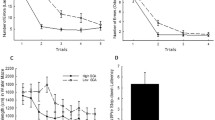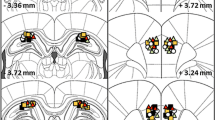Summary
The hippocampal NMDA-receptor is predominantly involved to establish long-term potentation (LTP) which is assumed to underlie fundamental molecular mechanisms of learning and memory. In the present study, NMDA-receptor density was investigated in parietotempral cerebral cortex and in hippocampus of commonly bred naive adult male Wistar rats which had performed well or poorly in the passive avoidance paradigm. NMDA-receptor binding was determined in saturation experiments using (3H) MK-801 as a ligand and data for K d and Bmax were calculated from Scatchard plots. In general, higher NMDA receptor density was found in the hippocampus as compared to parietotemporal cerebral cortex. This regional difference became particularly obvious in good performers but was abolished in poor performers. In the hippocampus, a significantly higher NMDA-receptor density could be found in rats which had performed well in the passive avoidance task as compared to poor performers. In contrast, no such differences could be found in parietotemporal cerebral cortex. The data may indicate that the reduction in hippocampal NMDA-receptor density is of functional importance, for cognitive abilities in both physiological and pathophysiological conditions.
Similar content being viewed by others
References
Bashir ZI, Bortolotto ZA, Davies CH, Berretta N, Irving AJ, Seal AJ, Henley JM, Jane DE, Watkins JC, Collingridge GL (1993) Induction of LTP in the hippocampus needs synaptic activation of glutamate metabotropic receptors. Nature 363: 347–350
Baudry M, Arst DS, Lynch G (1981) Increased (3H) glutamate receptor binding in aged rats. Brain Res 223: 195–198
Benke TA, Jones OT, Collingridge GL, Angelides KJ (1993) N-methyl-D-aspartate receptors are clustered and immobilized on dendrites of living cortical neurons. Proc Natl Acad Sci USA 90: 7819–7823
Benvenga MJ, Spaulding TC (1988) Amnesic effect of the novel anticonvulsant MK-801. Pharmacol Biochem Behav 30: 205–207
Black JE, Greenough WT (1986) Developmental approaches to the memory process. In: Martinez JL Jr, Kesner RP (eds) Learning and memory: a biological view. Academic Press, San Diego, pp 55–81
Bliss TVP, Collingridge GL (1993) A synaptic model of memory: long-term potentation in the hippocampus. Nature 361: 31–39
Bonthius DJ, West J (1991) Permanent neuronal deficits in rats exposed to alcohol during the brain growth spurt. Teratology 44: 147–163
Cohen SA, Müller WE (1992) Age-related alterations of NMDH-receptor properties in the mouse forebrain: partial restoration by chronic phosphatidylserine treatment. Brain Res 584: 174–180
Collingridge GL (1987) The role of NMDA receptors in learning and memory. Nature 330: 604–605
Collingridge GL, Bliss TVP (1987) NMDA receptors — their role in long-term potentation. Trends Neurosci 10: 288–293
Dalrymple-Alford JC, Benton D (1984) Preoperative differential housing and dorsal hippocampal lesions in rats. Behav Neurosci 98: 23–34
Danysz W, Wroblewski JT, Costa E (1988) Learning impairment in rats by N-methyl-D-aspartate receptor antagonists. Neuropharmacology 27: 653–656
De Toledo-Morrell L, Geinisman Y, Morrell F (1988) Age-dependent alterations in hippocampal synaptic plasticity: relation to memory disorders. Neurobiol Aging 9: 581–590
Farooqui AA, Horrocks LA (1991) Excitatory amino acid receptors, neural membrane phospholipid metabolism and neurological disorders. Brain Res Rev 16: 171–191
Gasic GP, Heinemann S (1991) Receptors coupled to ionic channels: the glutamate receptor family. Curr Opin Neurobiol 1: 20–26
Greenough WT, Hwang HMF, Gorman C (1985) Evidence for active synapse formation or altered postsynaptic metabolism in visual cortex of rats reared in complex environments. Proc Natl Acad Sci USA 82: 4549–4552
Ingram DK, Garafalo P, Spangler EL, Mantione CR, Odano I, London ED (1992) Reduced density of NMDA receptors and increased sensitivity to dizocilpine-induced learning impairment in aged rats. Brain Res 580: 273–280
Kadar T, Silbermann M, Brandeis R, Levy A (1990a) Age-related structural changes in the rat hippocampus: correlation with working memory deficiency. Brain Res 512: 113–120
Kadar T, Silbermann M, Weissman BA, Levy A (1990b) Age-related changes in the cholinergic components within the central nervous system. II. Working memory impairment and its relation to hippocampal muscarinic receptors. Mech Ageing Dev 55: 139–149
Keller EA, Borghese CM, Carrer HF, Ramirez OA (1992) The learning capacity of high or low performance rats is related to the hippocampus NMDA receptors. Brain Res 576: 162–164
Kesner RP, Hardy JD, Calder LD (1981) Phencyclidine and behavior. I. Sensory motor function, activity level, taste aversion and water intake. Pharmacol Biochem Behav 15: 7–13
Kim JJ, Foy MR, Thompson RF (1996) Behavioral stress modifies hippocampal plasticity through N-methyl-D-aspartate receptor activation. Proc Natl Acad Sci USA 93: 4750–4753
Kitamura Y, Zhao XH, Ohnuki T, Takei M, Nomura Y (1992) Age-related changes in transmitter glutamate and NMDA receptor/channels in the brain of senescence accelerated mouse. Neurosci Lett 137: 169–172
Landfield PW (1988) Hippocampal neurobiological mechanisms of age-related memory dysfunction. Neurobiol Aging 9: 571–579
Lowry OH, Rosebrough NJ, Farr AL, Randall RJ (1951) Protein measurement with the Folin phenol reagent. J Biol Chem 193: 265–275
Lynch G, Baudry M (1984) The biochemistry of memory: a new and specific hypothesis. Science 224: 1057–1063
Maragos WF, Chu DCM, Greenamyre JT, Penny JB, Young AB (1986) High correlation between the localization of (3H)-TCP binding and NMDA receptors. Eur J Pharmacol 123: 173–174
Mayer G, Nitsch R, Hoyer S (1990) Effects of changes in peripheral and cerebral glucose metabolism on locomotor activity, learning and memory in adult male rats. Brain Res 532: 95–100
Monaghan DT, Cotman CW (1985) Distribution of N-methyl-D-aspartate-sensitive L-(3H) glutamate-binding sites in rat brain. J Neurosci 5: 2909–2919
Morgene PJ, Miller M, Temper T, Stern W, Forbes W, Hall R, Bronzino J, Kissane J, Hawrylewicz E, Resnik O (1978) The effect of protein malnutrion on the developing central nervous system in the rat. Neurosci Biobehav Rev 2: 137–221
Morris RGM (1989) Synaptic plasticity and learning: selective impairment of learning in rats and blockade of long-term potentiation in vivo by the N-methyl-D-aspartate receptor antagonist AP5. J Neurosci 9: 3040–3057
Morris RGM, Anderson E, Lynch GS, Baudry M (1986) Selective impairment of learning and blockade of long-term potentiation by an N-methyl-D-aspartate receptor antagonist, AP5. Nature 319: 774–776
Olton DS, Papas BC (1979) Spatial memory and hippocampal function. Neuropsychologia 17: 669–682
Pellymounter MA, Beatty G, Gallagher M (1990) Hippocampal3H-CPP binding and spatial learning deficits in aged rats. Psychobiology 18: 298–304
Ramirez OA, Orsingher OA, Carrer HF (1988) Differential threshold for long-term potentiation in the hippocampus of rats with inborn high or low learning capacity. Neurosci Lett 92: 275–279
Sakimura K, Kutsuwada T, Ito I, Manabe T, Takayama C, Kushiya E, Yagi T, Alzawa S, Inoue Y, Sugiyama H, Mishina M (1995) Reduced hippocampal LTP and spatial learning in mice lacking NMDA receptor 21 subunit. Nature 373: 151–155
Scheuer K, Stoll S, Paschke U, Weigel R, Müller WE (1995) N-methyl-D-aspartate receptor density and membrane fluidity as possible determinants of the decline of passive avoidance performance in aging. Pharmacol Biochem Behav 50: 65–70
Schwegler H, Buselmaier W (1981) Behavior genetic analysis of water-T-maze learning in inbred strains of mice, their hybrids, and selected second generation crosses. Psychol Res 43: 335–345
Siesjö BK (1978) Brain energy metabolism. Wiley, Chichester
Siesjö BK (1981) Cell damage in the brain: a speculative synthesis. J Cereb Blood Flow Metab 1: 155–185
Speiser Z, Uziel J, Defrin-Assa R, Gitter S, Urca G (1991) Different behavioral deficits are induced by anoxia/hypoxia in neonatal and senescent rats: blockade by MK-801. Behav Brain Res 42: 181–186
Sugihara H, Moriyoshi K, Ishii T, Masu M, Nakanishi S (1992) Structures and properties of seven isoforms of the NMDA receptor generated by alternative splicing. Biochem Biophys Res Commun 185: 826–832
Venable N, Kelly PH (1990) Effects of NMDA receptor antagonists on passive avoidance learning and retrieval in rats and mice. Psychopharmacology 100: 215–221
Wenk GL, Grey CM, Ingram DK, Spangler EL, Olton DS (1989) Retention of maze performance inversely correlates with N-methyl-D-aspartate receptor number in hippocampus and frontal neocortex in the rat. Behav Neurosci 103: 688–690
Wishaw IQ, Auer RN (1989) Immediate and long-lasting effects of MK-801 on motor activity, spatial navigation in a swimming pool and EEG in the rat. Psychopharmacology 98: 500–507
Wu YK, Sun FF, Tong DM, Taylor BM (1986) Changes in membrane properties during energy depletion-induced cell injury studied with fluorescence microscopy. Biophys J 71: 91–100
Young AB, Fagg GB (1990) Excitatory amino acid receptors in the brain: membrane binding and receptor autoradiographic approaches. Trends Pharrnacol Sci 11: 126–133
Author information
Authors and Affiliations
Rights and permissions
About this article
Cite this article
Stecher, J., Müller, W.E. & Hoyer, S. Learning abilities depend on NMDA-receptor density in hippocampus in adult rats. J. Neural Transmission 104, 281–289 (1997). https://doi.org/10.1007/BF01273188
Received:
Accepted:
Issue Date:
DOI: https://doi.org/10.1007/BF01273188




